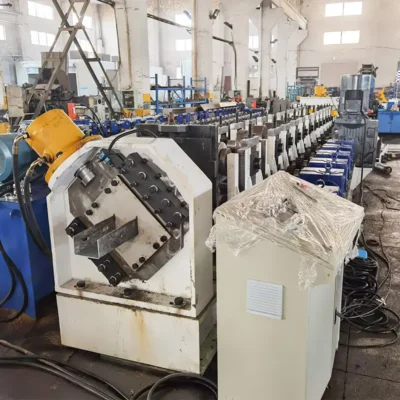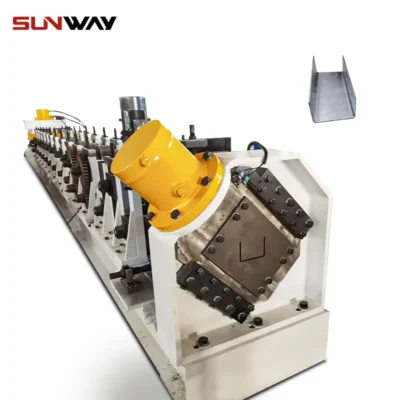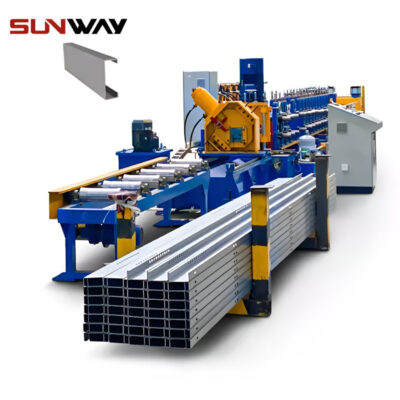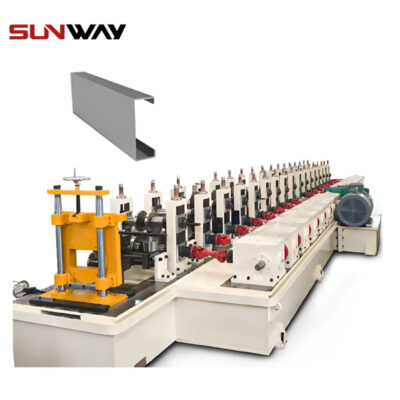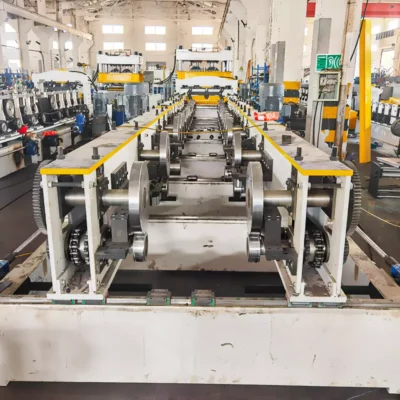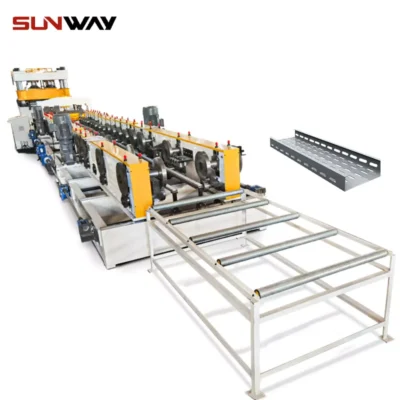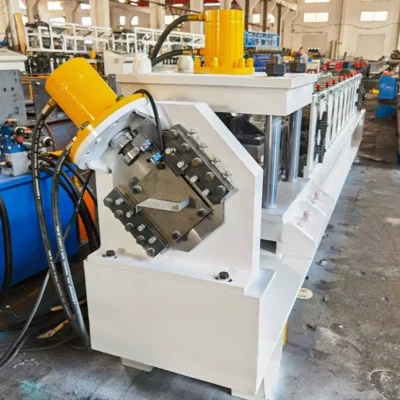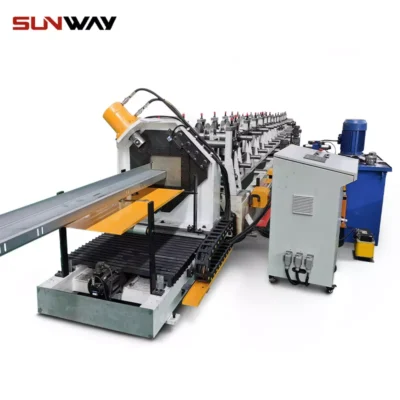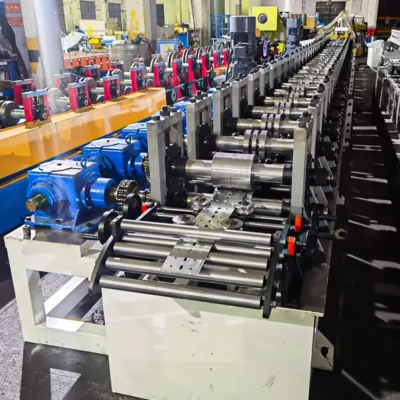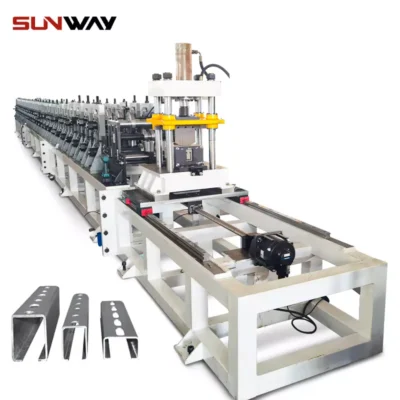The HVAC (Heating, Ventilation, and Air Conditioning) industry is growing at an astonishing pace, driven by the increasing demand for energy-efficient, durable, and cost-effective solutions. At the heart of this transformation lies the Air Conditioner Roll Forming Machine, an innovative piece of equipment designed to streamline the production of air conditioner components.
From condenser plates to duct panels, Air Conditioner Roll Forming Machines allow manufacturers to produce high-quality, precision-engineered parts at scale. These machines are critical for meeting the HVAC industry’s demand for efficiency, sustainability, and customization. In this comprehensive guide, we’ll dive into applications, machine features, production workflows, pricing, global trends, and why Wuxi Sunway Machinery stands out as a trusted partner for roll-forming solutions.
What is an Air Conditioner Roll Forming Machine?
एक Air Conditioner Roll Forming Machine is a specialized system used to manufacture various components of air conditioning units and HVAC systems. These machines process flat metal sheets or coils—such as galvanized steel, aluminum, or stainless steel—into custom profiles that form the structural and functional parts of air conditioners.
Key Components Produced
- Condenser Plates: The backbone of the heat exchange process in air conditioners.
- Duct Panels: Channels that direct airflow in HVAC systems.
- Casing Panels: Outer shells that enclose the air conditioning unit.
- Reinforcement Supports: Structural components that enhance durability.
- Custom Profiles: Parts tailored to unique HVAC designs and configurations.
By automating the production process, Air Conditioner Roll Forming Machines ensure consistency, scalability, and cost-efficiency, making them an indispensable asset for HVAC manufacturers.
Applications of Air Conditioner Roll Forming Machines
The versatility of Air Conditioner Roll Forming Machines allows them to cater to a wide range of applications within HVAC manufacturing. Let’s explore how these machines are shaping the industry:
1. Residential Air Conditioning Units
- Use Case: Producing lightweight and compact panels for home air conditioners.
- Why It Matters: Enables the efficient production of cost-effective units for the residential market.
2. Commercial HVAC Systems
- Use Case: Manufacturing duct panels and casings for large-scale systems used in offices, malls, and industrial facilities.
- Why It’s Essential: Provides durable and high-performing components for energy-efficient air distribution.
3. Automotive Air Conditioning
- Use Case: Producing compact profiles for air conditioning systems in vehicles.
- Why It’s Important: Ensures precision and durability in the confined spaces of automotive HVAC systems.
4. Industrial Cooling Systems
- Use Case: Crafting robust condenser plates and reinforcement supports for heavy-duty industrial air conditioners.
- Why It’s Critical: Ensures reliable cooling performance in demanding industrial environments.
5. Custom HVAC Designs
- Use Case: Creating unique profiles and parts for specialized HVAC solutions in data centers, hospitals, and laboratories.
- Why It’s Relevant: Supports the growing demand for tailored systems with specific performance requirements.
6. Air Purification Systems
- Use Case: Manufacturing structural components for air purification and filtration units.
- Why It’s Useful: Enhances air quality in residential, commercial, and industrial spaces.
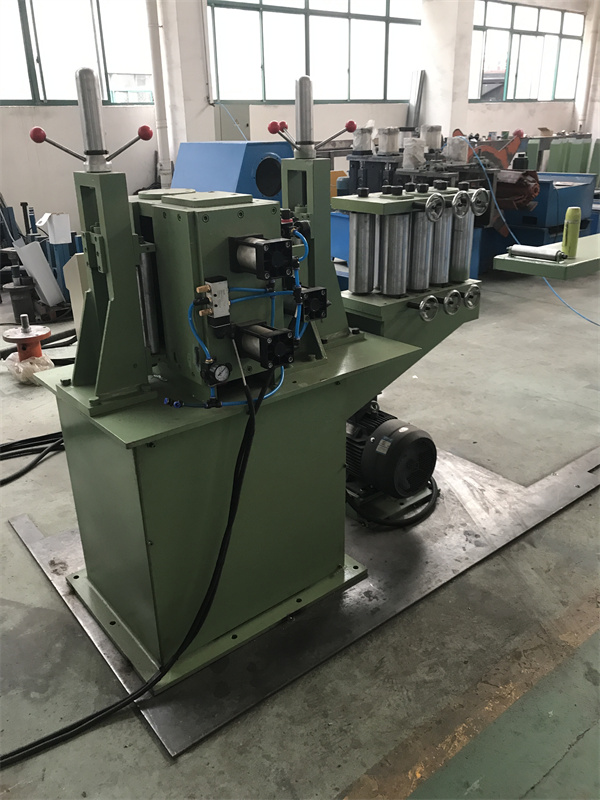
Key Features of Wuxi Sunway Air Conditioner Roll Forming Machines
Wuxi Sunway Machinery is renowned for its cutting-edge roll-forming technology, and their Air Conditioner Roll Forming Machines are no exception. Here’s what makes their machines the top choice for HVAC manufacturers:
1. High Precision and Consistency
- What It Offers: Dimensional tolerances as low as ±0.1mm.
- Why It’s Critical: Ensures a perfect fit for air conditioning components, minimizing assembly issues.
2. Multi-Material Compatibility
- Supported Materials:
- Galvanized Steel
- Aluminum
- Stainless Steel
- Why It Matters: Provides flexibility to produce parts with varying strength, weight, and corrosion resistance.
3. High-Speed Production
- Performance: Capable of producing up to 20–40 meters of profiles per minute, depending on material and complexity.
- Why It’s Beneficial: Meets the high-volume demands of the HVAC industry.
4. Integrated Punching and Cutting
- What It Offers: Built-in systems for punching holes, slots, and perforations while cutting parts to length.
- Why It’s Essential:
- Eliminates secondary operations.
- Ensures precision alignment for complex components.
5. IoT and Automation Integration
- What It Enables: Real-time monitoring, automated adjustments, and predictive maintenance using IoT technology.
- Why It’s Game-Changing:
- Enhances production efficiency.
- Reduces downtime and material waste.
- Provides actionable insights for data-driven decision-making.
6. Modular Design
- What It Provides: Machines with modular configurations that can be expanded or upgraded as production needs grow.
- Why It’s Future-Proof: Accommodates evolving market demands, ensuring long-term ROI.
7. Energy Efficiency
- The Innovation: Optimized motors and workflows minimize power consumption during production.
- Why It’s Significant: Reduces operational costs and aligns with sustainability goals.
Production Workflow of an Air Conditioner Roll Forming Machine
The production process for air conditioner components is designed for maximum precision and efficiency. Here’s a typical workflow:
1. Material Loading
- Metal sheets or coils are mounted on the machine’s decoiler, which feeds the material into the system.
2. Straightening and Leveling
- A leveling unit ensures the material is flat and defect-free before entering the roll-forming section.
3. Roll Forming
- The material passes through a series of rollers that gradually shape it into the desired profile.
4. Punching and Cutting
- Integrated punching systems create holes or slots for assembly and airflow, while precision cutters trim parts to the required lengths.
5. Quality Inspection
- Finished components are inspected for dimensional accuracy, surface finish, and compliance with industry standards.
6. Stacking and Packaging
- Completed parts are stacked, bundled, and prepared for transportation or delivery to assembly lines.
Pricing of Air Conditioner Roll Forming Machines
The cost of an Air Conditioner Roll Forming Machine varies based on its features, production capacity, and customization options. Below is a general pricing guide for 2025:
| Machine Type | Capabilities | Price Range (USD) |
|---|---|---|
| Standard Machines | Basic profile production | $150,000–$300,000 |
| Advanced Machines | High-speed and multi-profile output | $300,000–$600,000 |
| Customizable Machines | Including punching, IoT, and automation | $600,000–$1,000,000 |
For detailed pricing and financing options, contact Wuxi Sunway Machinery.
Market Trends for Air Conditioner Roll Forming Machines in 2025
The HVAC industry is evolving rapidly, and Air Conditioner Roll Forming Machines are at the forefront of this transformation. Here are the key trends shaping the market:
1. Energy Efficiency Standards
- The Trend: Governments and organizations are enforcing stricter energy efficiency regulations for HVAC systems.
- How Machines Help:
- Enable the production of lightweight, high-performing components.
- Support the development of energy-efficient air conditioners.
2. Urbanization and Infrastructure Growth
- The Push: Rising urbanization is driving demand for HVAC systems in residential and commercial buildings.
- Machine Contribution:
- Facilitates high-volume production to meet growing market needs.
- Offers customizable solutions for diverse applications.
3. Sustainability Practices
- The Opportunity: Manufacturers are prioritizing eco-friendly practices and materials.
- How Machines Help:
- Minimize material waste through precision engineering.
- Process recyclable metals to align with sustainability goals.
FAQs About Air Conditioner Roll Forming Machines
| Question | Answer |
|---|---|
| What materials can these machines process? | Galvanized steel, stainless steel, and aluminum are commonly used. |
| What is the average production speed? | Machines can produce up to 20–40 meters of profiles per minute, depending on material and complexity. |
| Can these machines handle custom designs? | Yes, Wuxi Sunway machines are equipped with customizable tooling for bespoke profiles. |
| What industries benefit most from these machines? | HVAC manufacturing, automotive, industrial cooling, and air purification systems. |
| Are these machines energy-efficient? | Absolutely! Wuxi Sunway machines feature energy-saving motors and optimized workflows. |
| Do these machines comply with global standards? | Yes, they meet ISO, ANSI, EN, and other international safety and quality standards. |
| Is training provided with the purchase? | Yes, Wuxi Sunway offers comprehensive training and after-sales support for all customers. |
Real-World Applications of Air Conditioner Roll Forming Machines
To fully appreciate the impact of Air Conditioner Roll Forming Machines, let’s review some real-world scenarios where these machines have revolutionized component production.
1. Large-Scale Commercial HVAC Installations
- Scenario: A real estate developer was tasked with installing HVAC systems in a new high-rise building.
- Machine Contribution:
- Produced lightweight duct panels for efficient airflow in the building’s ventilation system.
- Enabled high-speed production to meet tight project deadlines.
- Delivered components with precision perforations, ensuring easy installation and seamless integration with other HVAC elements.
2. Automotive HVAC Systems
- Scenario: An automotive manufacturer needed compact and durable air conditioning components for its latest line of electric vehicles (EVs).
- Machine Contribution:
- Crafted small-scale profiles and condenser plates designed to fit the limited space in EVs.
- Used lightweight materials like aluminum to optimize vehicle energy efficiency.
- Delivered high-quality components that met the rigorous safety and performance standards of the automotive industry.
3. Data Center Cooling Systems
- Scenario: A tech company required specialized cooling systems for its data center to maintain optimal server performance.
- Machine Contribution:
- Produced custom cooling ducts and condenser plates capable of handling high thermal loads.
- Used corrosion-resistant materials to ensure longevity in a high-moisture environment.
- Supported modular designs for scalable cooling system expansion as the data center grew.
4. Renewable Energy HVAC Solutions
- Scenario: A renewable energy firm was developing sustainable cooling systems for solar-powered residential communities.
- Machine Contribution:
- Manufactured eco-friendly air conditioning components using recyclable materials.
- Enabled the production of energy-efficient profiles tailored to reduce power consumption.
- Delivered cost-effective solutions aligned with the sustainability goals of the project.
5. High-Performance Industrial Cooling Systems
- Scenario: A manufacturing facility required robust air conditioning systems to maintain consistent cooling for its machinery.
- Machine Contribution:
- Produced heavy-duty condenser plates and reinforcement supports for industrial-grade cooling systems.
- Integrated punching features to create complex perforations for optimized airflow.
- Delivered high-strength components capable of withstanding harsh industrial conditions.
How Automation Enhances Air Conditioner Roll Forming Machines
Automation is redefining the production landscape for HVAC components. Air Conditioner Roll Forming Machines equipped with advanced automation features offer unparalleled efficiency, consistency, and scalability.
1. Real-Time Monitoring
- Feature: IoT sensors track machine performance, material usage, and production output.
- Advantage:
- Identifies inefficiencies and potential issues before they lead to downtime.
- Provides actionable insights for optimizing production processes.
2. Automated Adjustments
- Feature: Machines automatically adjust roller configurations to accommodate different profiles or material thicknesses.
- Advantage:
- Reduces manual intervention, saving time and labor costs.
- Ensures consistent quality across diverse production runs.
3. High-Speed Production
- Feature: Advanced motor systems enable rapid material processing without compromising accuracy.
- Advantage:
- Meets the high-volume demands of the HVAC industry.
- Supports quick turnaround times for large-scale projects.
4. Integrated Punching and Cutting
- Feature: Built-in systems for creating perforations, slots, and custom designs while cutting components to the required lengths.
- Advantage:
- Eliminates secondary operations, reducing production time.
- Ensures precision and uniformity in complex designs.
5. Energy Efficiency
- Feature: Optimized workflows and energy-saving motors minimize power consumption.
- Advantage:
- Reduces operational costs.
- Aligns with sustainability goals by lowering the carbon footprint of manufacturing operations.
6. Predictive Maintenance
- Feature: Advanced software analyzes machine data to predict when maintenance is required.
- Advantage:
- Minimizes unexpected downtime.
- Extends machine lifespan by ensuring timely repairs and servicing.
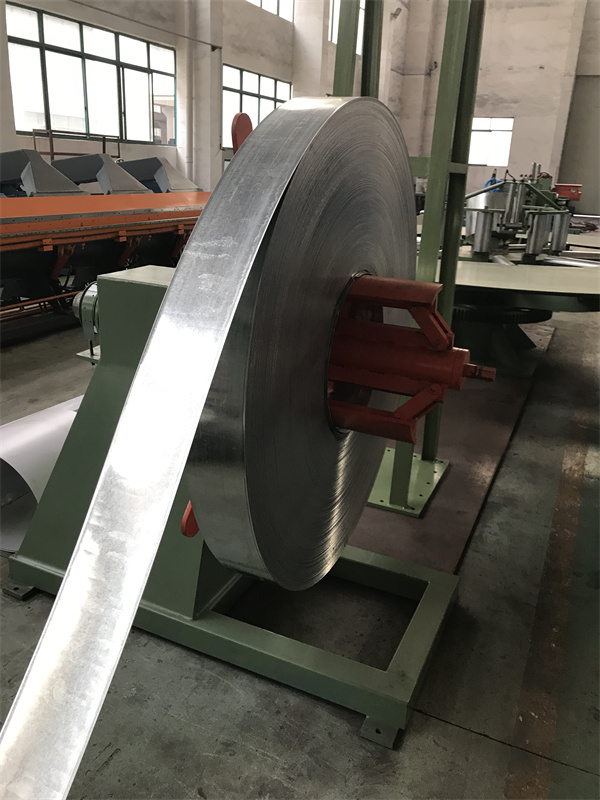
Global Compliance Standards for Air Conditioner Components
To ensure safety, reliability, and energy efficiency, air conditioning components must comply with strict international standards. Wuxi Sunway Machinery designs its roll-forming machines to produce parts that meet these requirements.
| Standard | Region | Requirement |
|---|---|---|
| ISO 9001 | Global | Focuses on quality management systems for consistent production processes. |
| ISO 14001 | Global | Governs environmental management practices to minimize ecological impact. |
| ASHRAE Standards | USA | Covers performance criteria for HVAC systems and equipment. |
| CE Marking | Europe | Certifies compliance with EU safety, health, and environmental requirements. |
| JIS B9920 | Japan | Governs the design and performance of HVAC equipment and components. |
| EN 1886 | Europe | Specifies mechanical performance standards for ventilation and air conditioning units. |
By adhering to these standards, Wuxi Sunway Machinery ensures that the components produced by their machines are safe, durable, and energy-efficient.
FAQs About Air Conditioner Roll Forming Machines
| Question | Answer |
|---|---|
| What materials can these machines process? | Galvanized steel, stainless steel, aluminum, and pre-coated metals are commonly used. |
| What is the average production speed? | Machines can produce up to 20–40 meters of profiles per minute, depending on material and complexity. |
| Can these machines handle custom designs? | Yes, Wuxi Sunway machines are equipped with customizable tooling for bespoke profiles. |
| What industries benefit most from these machines? | HVAC manufacturing, automotive cooling systems, industrial cooling, and renewable energy solutions. |
| Are these machines energy-efficient? | Absolutely! Wuxi Sunway machines feature energy-saving motors and optimized workflows. |
| Do these machines comply with global standards? | Yes, they meet ISO, ASHRAE, EN, and other international safety and quality standards. |
| Is training provided with the purchase? | Yes, Wuxi Sunway offers comprehensive training and after-sales support for all customers. |
| What is the typical lifespan of these machines? | With proper maintenance, these machines last 15–25 years or more. |
| Can these machines produce multiple components? | Yes, they are designed to handle diverse profiles, from ducts to condenser plates. |
Why Wuxi Sunway Machinery is the Industry Leader
Wuxi Sunway Machinery is a globally recognized leader in roll-forming solutions for HVAC component manufacturing. Here’s why they are the preferred partner for businesses worldwide:
- Decades of Expertise: With years of experience, Wuxi Sunway delivers innovative and reliable roll-forming machines tailored to industry needs.
- Global Clientele: Trusted by manufacturers across Asia, Europe, the Americas, and beyond.
- Advanced Technology: Features such as IoT integration, high-speed production, and customizable tooling set Wuxi Sunway apart.
- Sustainability Commitment: Machines are engineered to align with eco-friendly practices, reducing waste and energy consumption.
- Comprehensive Support: From installation to training and after-sales service, Wuxi Sunway ensures seamless operations for its customers.
Conclusion: Shaping the Future of HVAC Manufacturing
The Air Conditioner Roll Forming Machine is more than just a tool; it’s a driver of innovation and efficiency in the HVAC industry. By enabling the production of precision-engineered, energy-efficient components, these machines are helping manufacturers meet the growing global demand for reliable cooling solutions.
Looking to upgrade your production capabilities? Partner with Wuxi Sunway Machinery today and explore their world-class roll-forming solutions. Together, let’s build a sustainable and efficient future for HVAC manufacturing—one profile at a time!

